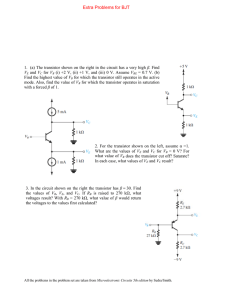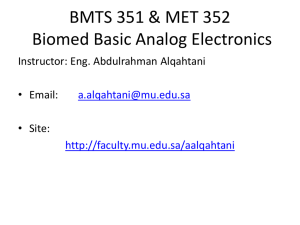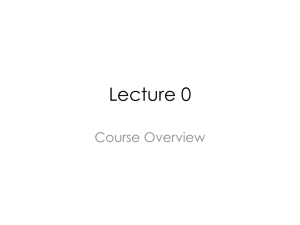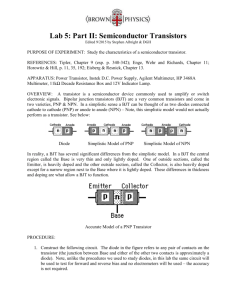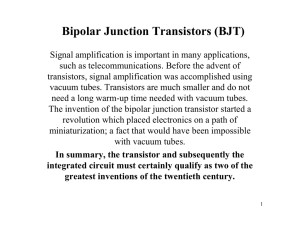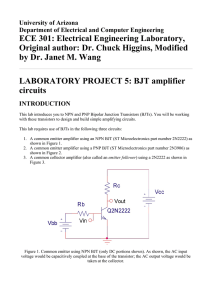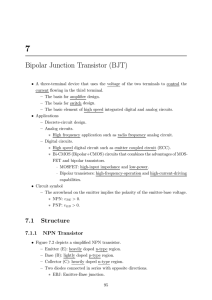The Bipolar Junction Transistor (BJT)
advertisement
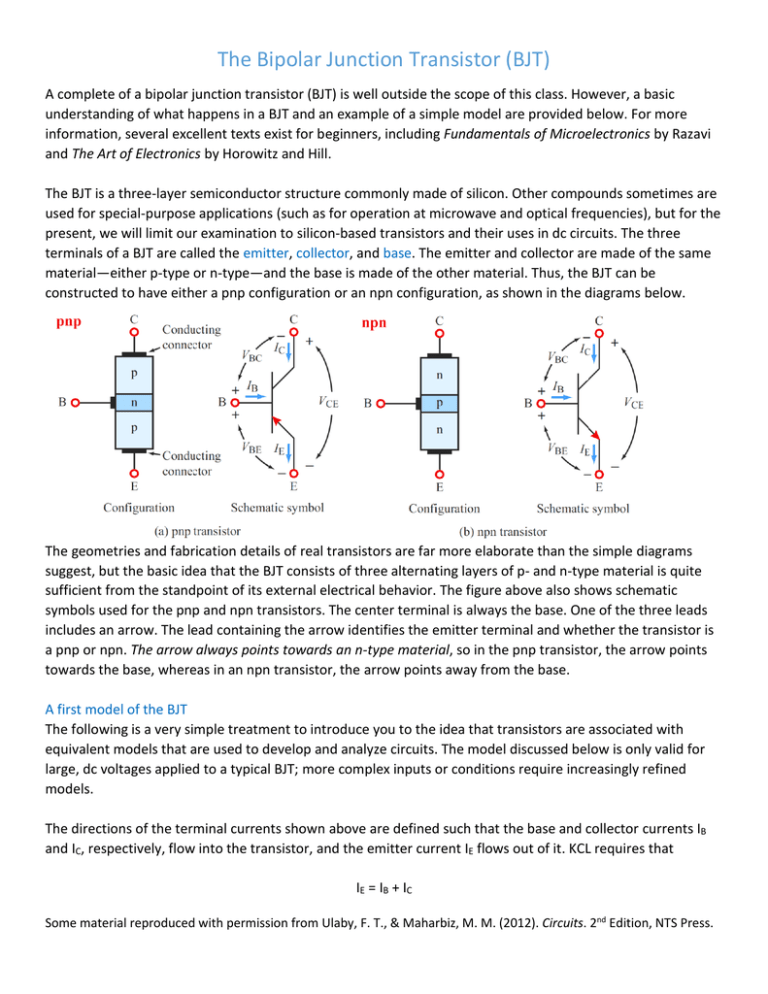
The Bipolar Junction Transistor (BJT) A complete of a bipolar junction transistor (BJT) is well outside the scope of this class. However, a basic understanding of what happens in a BJT and an example of a simple model are provided below. For more information, several excellent texts exist for beginners, including Fundamentals of Microelectronics by Razavi and The Art of Electronics by Horowitz and Hill. The BJT is a three-layer semiconductor structure commonly made of silicon. Other compounds sometimes are used for special-purpose applications (such as for operation at microwave and optical frequencies), but for the present, we will limit our examination to silicon-based transistors and their uses in dc circuits. The three terminals of a BJT are called the emitter, collector, and base. The emitter and collector are made of the same material—either p-type or n-type—and the base is made of the other material. Thus, the BJT can be constructed to have either a pnp configuration or an npn configuration, as shown in the diagrams below. The geometries and fabrication details of real transistors are far more elaborate than the simple diagrams suggest, but the basic idea that the BJT consists of three alternating layers of p- and n-type material is quite sufficient from the standpoint of its external electrical behavior. The figure above also shows schematic symbols used for the pnp and npn transistors. The center terminal is always the base. One of the three leads includes an arrow. The lead containing the arrow identifies the emitter terminal and whether the transistor is a pnp or npn. The arrow always points towards an n-type material, so in the pnp transistor, the arrow points towards the base, whereas in an npn transistor, the arrow points away from the base. A first model of the BJT The following is a very simple treatment to introduce you to the idea that transistors are associated with equivalent models that are used to develop and analyze circuits. The model discussed below is only valid for large, dc voltages applied to a typical BJT; more complex inputs or conditions require increasingly refined models. The directions of the terminal currents shown above are defined such that the base and collector currents IB and IC, respectively, flow into the transistor, and the emitter current IE flows out of it. KCL requires that IE = IB + IC Some material reproduced with permission from Ulaby, F. T., & Maharbiz, M. M. (2012). Circuits. 2nd Edition, NTS Press. Under normal operating conditions, IE has the largest magnitude of the three currents, and IB is much smaller than either IC or IE. The transistor can operate under both dc and ac conditions, but we will limit our present discussion to dc circuits. For simplicity, we will consider only the npn common-emitter configuration. Accordingly, we can describe the operation of the npn transistor by the dc equivalent model shown below. The circuit contains a constant dc voltage source VBE and a dependent current-controlled current source that relates IC to IB by IC = βIB where β is a transistor parameter called the common emitter current gain. Under normal operation for silicon transistors, VBE ~ 0.7 V, and β may assume values in the range between 30 and 1000, depending on its specific design configuration. Note that to operate in its active mode, the transistor requires that certain dc voltages be applied at its base and collector terminals. We refer to these voltages as VBB and VCC, respectively. Example Apply the equivalent-circuit model with VBE ~ 0.7 V and β = 200 to determine IB, IC, and VCE in the circuit Below. Assume that VBB = 2 V, VCC = 10 V, RB = 26 kΩ, and RC = 200 Ω. Upon replacing the npn transistor with its equivalent circuit, we end up with the circuit shown below. Some material reproduced with permission from Ulaby, F. T., & Maharbiz, M. M. (2012). Circuits. 2nd Edition, NTS Press. In the left-hand loop, KVL gives Which leads to Given β = 200, and Note how the circuit provides an output (VCE) which is an amplified version of the input. Also note that the transistor requires an external source (VCC) to perform its amplification. A transistor does not, by itself, inject any energy into the circuit. Some material reproduced with permission from Ulaby, F. T., & Maharbiz, M. M. (2012). Circuits. 2nd Edition, NTS Press.

